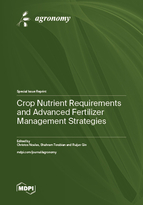Crop Nutrient Requirements and Advanced Fertilizer Management Strategies
A special issue of Agronomy (ISSN 2073-4395). This special issue belongs to the section "Soil and Plant Nutrition".
Deadline for manuscript submissions: closed (10 March 2023) | Viewed by 45082
Special Issue Editors
Interests: soil fertility; nutrition and fertilization of agricultural crops; nitrogen use efficiency; plant nutritional physiology; soil-plant relations; land use and soil quality; arable crop production; root morphology; crop nutrition
Special Issues, Collections and Topics in MDPI journals
Interests: crop physiology; crop nutrient management; organic fertilizers
Interests: nutrient and water management; soil fertility; soil reclamation; plant nutrition; plant root; conservation tillage; cropping systems; crop production; sustainable agriculture and environmental protection
Special Issue Information
Dear Colleagues,
From an estimated 7.8 billion people worldwide in 2021, projections indicate global population growth to around 8.5 billion by 2030, and to almost 10.0 billion by 2050. As a result, the challenge for the coming decades will be to ensure long-term food security of the ever-growing world population by increasing crop productivity using sustainable agricultural practices, whilst at the same time maintaining soil health and preserving the quality of the environment. This must be accomplished in the context of the shrinking availability of arable land and shortage of fossil fuels. However, crop production depends on several interrelated agronomic factors, such as soil (e.g., pH, texture, organic matter content, water holding capacity, mineral composition and nutrient availability, etc.), plant genetic material, crop management, and several other biotic and abiotic factors. The role of roots which has often been neglected should also be taken into consideration for better resource acquisition. Apart from soil testing and nutrient removal by harvestable products which are traditionally used to derive the amounts of nutrients required by the crop, root system architecture (RSA),and root system morphology (RSM) will also play a crucial role in our understanding on how roots capture heterogeneously distributed or limited resources while maintaining whole plant performance. Crop nutrition and balanced fertilization (both from inorganic and organic sources) are considered among the primary actions towards satisfactory crop growth and production while decreasing production costs. Balanced fertilization refers to the application of plant nutrients in optimum quantities and in the right proportions through appropriate methods and at the right times for a specific crop’s needs and agroclimatic conditions. In this context, the development of novel and sophisticated fertilization practices is the challenge for future nutrient management that helps to improve crop Nutrient Use Efficiency (NUE), maintain adequate levels of soil nutrients, and prevent deficiencies, imbalance or overuse of fertilizers, leading to economic and environmental benefits. However, crop-specific information on nutrient management, including diverse nutrient sources as part of an integrated nutrient management as well as improving NUE by developing novel and practical fertilizer recommendations for farmers, needs to be further explored under diverse pedoclimatic environments.
The focus of this Special Issue is on nutrient use efficiency (NUE)-related parameters in arable cropping systems, from the agronomic perspective to environmental considerations. Moreover, it will focus on the physiological basis of genotypic differences in the uptake and utilization of key nutrients and provide demonstrated experimental data in order to optimize fertilizer management. The role of roots will also be taken into account as key parameters for improving NUE, especially under field conditions, which is central but still under debate. It will provide a better understanding of how crop plants acquire water and nutrients through their roots and maintain growth and performance under diverse pedoclimatic conditions. Finally, we will try to identify the barriers that exist to the improvement of nutrient management and which interventions can lead farmers along pathways towards adoption of novel and more profitable and sustainable fertilization strategies.
With the rising costs of inorganic fertilizers due to a shortage of fossil fuels and the negative environmental impacts of excessive fertilization, this Special Issue will provide some evidence of the usefulness of improving fertilizer use efficiency of crops, thus ensuring enough food of acceptable quality, taking into account environmental considerations.
We welcome original and novel research articles and reviews on all aspects of arable crop NUE and advanced fertilization management which will improve our understanding of the mechanisms underlying the nutrient uptake, as well as the complex interactions between soil, water and root growth for efficient resource capture linked to whole plant crop performance.
Dr. Christos Noulas
Dr. Shahram Torabian
Dr. Ruijun Qin
Guest Editors
Manuscript Submission Information
Manuscripts should be submitted online at www.mdpi.com by registering and logging in to this website. Once you are registered, click here to go to the submission form. Manuscripts can be submitted until the deadline. All submissions that pass pre-check are peer-reviewed. Accepted papers will be published continuously in the journal (as soon as accepted) and will be listed together on the special issue website. Research articles, review articles as well as short communications are invited. For planned papers, a title and short abstract (about 100 words) can be sent to the Editorial Office for announcement on this website.
Submitted manuscripts should not have been published previously, nor be under consideration for publication elsewhere (except conference proceedings papers). All manuscripts are thoroughly refereed through a single-blind peer-review process. A guide for authors and other relevant information for submission of manuscripts is available on the Instructions for Authors page. Agronomy is an international peer-reviewed open access monthly journal published by MDPI.
Please visit the Instructions for Authors page before submitting a manuscript. The Article Processing Charge (APC) for publication in this open access journal is 2600 CHF (Swiss Francs). Submitted papers should be well formatted and use good English. Authors may use MDPI's English editing service prior to publication or during author revisions.
Keywords
- nutrient use efficiency
- nutrient dynamics
- enhanced fertilizers efficiency
- balanced fertilization strategies
- inorganic fertilizers
- organic fertilizers and biofertilizers
- new technology fertilizers
- root system architecture traits
- root morphology
- arable crops
- efficient genotypes
- soil–plant interactions
- macro-/micronutrient interactions.








